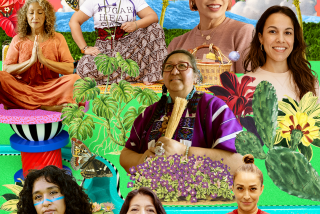Health Horizons : A Career With Sticking Power : After thousands of years as a key component of Asian medicine, acupunture is now a growing field of practice in the West. California has 11 licensed schools.
- Share via
Baljit Khalsa spent the 1950s in the Bronx, where his mother carted him off to the area’s sole health food store, fed him fresh vegetables and gave him megadoses of vitamins before it was fashionable.
Perhaps that’s one reason why, when given a choice between civil engineering and something a bit less traditional, he chose to become an acupuncturist in Beverly Hills.
“I was in Alaska doing construction and working in gold mines, and I was in a really bad car accident,” said Baljit, 43, who changed his name 20 years ago to reflect his interest in spirituality.
“The medicine in Alaska was archaic, and I felt miserable for a year,” he said. “So I came to Los Angeles to look for alternative treatment, and I tried acupuncture. After one treatment by a student at a school, I was 40% better.”
Within a month, at age 30, Baljit had enrolled in a Westwood acupuncture school. Three years of schooling and $25,000 later, he hung out his shingle as a licensed acupuncturist and doctor of Oriental medicine. Despite a steep office rental rate, a changing economy and lingering skepticism about the value and efficacy of acupuncture, herbal treatments and massage therapy, Baljit manages to “do OK” financially--taking home $60,000 to $80,000 a year. And he gets the satisfaction of helping to alleviate patients’ pain and encouraging them to take more responsibility for their health by improving diet and exercise habits.
“It’s an evolving career that is growing, and it’s an art,” Baljit said. “It’s a lot harder than people think.”
Acupuncture has been a key component of traditional Chinese medicine for thousands of years, but it didn’t make its way to the United States in a significant way until the 1970s. Its practitioners seek to reduce pain and treat conditions such as asthma, addiction and obesity through the insertion of needles, some of them thinner than a human hair. The insertions are believed to regulate the flow of energy along the body’s “meridians,” or pathways. Many acupuncturists also use herbal, massage and exercise therapies.
Acupuncture’s theories are shared by the Chinese, Korean and Japanese and are winning growing acceptance among Western doctors and hospitals, which are increasingly incorporating acupuncturists into their practices. In California, acupuncture is covered in some cases by Blue Cross, Medi-Cal, workers’ compensation and a few other insurance plans.
At Emperor’s College of Traditional Oriental Medicine in Santa Monica, enrollment is growing.
“Oriental medicine has been burgeoning nationally,” said Kathryn White, the school’s academic dean, who is also a clinical psychologist with a master’s in Oriental medicine. The school, which was founded in 1983, has about 240 students and a fast-rising number of applicants.
In California, which has the most rigorous acupuncture-licensing requirements in the nation, students must complete about 2,400 hours of schooling. For most students, that means going to school four quarters a year for four years. The total cost generally runs from $20,000 to $25,000.
More than 30 states now have programs for acupuncture licensing, up from 16 two years ago. California has 11 state-approved schools and 3,500 to 4,000 actively practicing acupuncturists, most of whom work in small offices or sole-proprietor clinics.
The programs at Emperor’s College and others incorporate classes in Western medicine, including anatomy and pathology. As the understanding of acupuncture and herbal treatment grows, mainstream colleges nationwide are also seeking to integrate the most effective aspects of Oriental medicine. UCLA, for example, has an East-West medical department, and Harvard University has a relationship with a prestigious Beijing medical organization. Oriental techniques are also being used in Britain and France.
Kimberly Kavanagh decided to become an acupuncturist and doctor of Oriental medicine after she was successfully treated for infertility at an acupuncture clinic in Santa Barbara. Having already received a degree in journalism and political science, she spent four additional years in school and now practices at the San Luis Obispo Holistic Medical Clinic.
Kavanagh believes the current effort to bring medical costs under control should help acupuncturists.
“We’re very cost-effective,” she said. (Fees vary widely, but many acupuncturists charge $70 to $90 per session. A thriving clinic at Emperor’s College, where patients are treated by students, charges $25 for the first visit and $20 for a follow-up.)
This month, the profession could get a public relations boost if the Food and Drug Administration rules that needles are medical devices and thereby approved as a treatment. They currently are considered to be “investigational medical devices,” meaning they are not officially sanctioned.
Even so, Ken Cherman, an acupuncturist active in the California Society for Oriental Medicine, a trade group in Sherman Oaks, said the field is ripe, even though it lacks the cachet of Western medicine and still suffers from a reputation among many as hocus-pocus.
“It’s a very young profession,” he said. “I think it’s a good career choice. More and more people are looking at acupuncture as an alternative to traditional medicine.”







